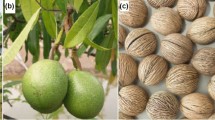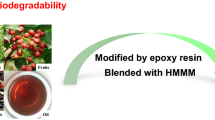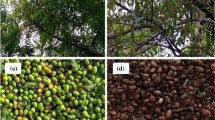Abstract
The high-unsaturated fatty acid content of Sacha inchi oil (SIO), a perennial plant originally from Peru, has turned it into a potential raw material for the production of alkyd resins. In this study, different proportions of multifunctional polyols were used to prepare air-drying resins. Physicochemical characteristics (acid value, viscosity, colour, density, drying time, and hardness) of alkyds were evaluated. Moreover, FT-IR, TG–DTA, 1H-NMR and 13C-NMR characterization techniques were used. SIO-based alkyd resins prepared with trimethylolpropane exhibited low viscosities, suitable for preparing more manageable high solids protective coatings.










Similar content being viewed by others
Data Availability
The raw/processed data required to reproduce these findings cannot be shared at this time due to legal or ethical reasons.
References
Satas D, Tracton A (2001) Alkyd Resins. Coatings Technology Handbook, 2nd edn. Marcel-Dekker Inc, New York, pp 51–57
Uglea C (1998) Ch. VI Alkyd Resins. In: Oligomer technology and applications. Marcel Dekker, Inc, New York, pp 373
Tuck N (2000) Ambient cure in alkyd resins. Volume VI Waterbone and Solvent Based Alkyd and their end user applications. John Wiley and Sons, London, pp 65–72
Deligny P, Tuck N (2000) Ch. II Alkyd Resins. In. Resins for Surface Coatings, Vol II Alkyds & Polyesters. John Wiley and Sons, New York, pp 31–100
Flores S, Flores A, Calderón C, Obregón D (2019) Synthesis and characterization of sacha inchi (Plukenetia volubilis L.) oil-based alkyd resin. Prog Org Coatings 136:105289. https://doi.org/10.1016/j.porgcoat.2019.105289
Hadzich A, Gross GA, Leimbach M et al (2020) Effect of polyalcohols on the anticorrosive behaviour of alkyd coatings prepared with drying oils. Prog Org Coatings 145:105671. https://doi.org/10.1016/j.porgcoat.2020.105671
Fanali C, Dugo L, Cacciola F et al (2011) Chemical characterization of Sacha inchi (Plukenetia volubilis L.) oil. J Agric Food Chem 59:13043–13049. https://doi.org/10.1021/jf203184y
Guillén M, Ruiz A, Cabo N, Chirinos R et al (2003) Characterization of Sacha Inchi (Plukenetia volubilis L.) oil by FTIR Spectroscopy and 1H NMR. Comparison with Linseed oil. J Amer Oil Chem Soc 80:755–762. https://doi.org/10.1007/s11746-003-0768-z
Bondioli P, Della BL (2006) Alpha linolenic acid rich oils. Composition of Plukenetia volubilis (Sacha Inchi) oil from Perú. Riv Ital Delle Sostanze Grasse 83:120–123
Lin KF (1992) Alkyd resins. In: Kirk Othmer Encyclopedia of Chemical Technology, Fourth edi. Wiley Interscience, New York
Prashantha MAB, Premachandra BAJK, Amarasinghe ADUS (2017) Synthesis of fast drying long oil alkyd resins using seed oil of Karawila (Momordica charantia). Indian J Chem Technol 24:47–54
Hadzich A, Gross GA, Leimbach M, et al (2020) Characterization of Plukenetia volubilis L. fatty acid-based alkyd resins. Polym Test 82:106296. https://doi.org/10.1016/j.polymertesting.2019.106296
Stoye D, Freitag W (1996) Resins for coatings - Chemistry, properties, and applications. Hanser-Gardner, Cincinnati
Wicks ZW, Jones FN, Pappas SP, Wicks DA (2007) Alkyd resins. In: Alkyd Resins: In Organic Coatings: Science and Technology. John Wiley & Sons, New Jersey, pp 306–325
Thanamongkollit N, Miller KR, Soucek MD (2012) Synthesis of UV-curable tung oil and UV-curable tung oil based alkyd. Prog Org Coatings 73:425–434. https://doi.org/10.1016/j.porgcoat.2011.02.003
Boruah M, Gogoi P, Adhikari B, Dolui SK (2012) Preparation and characterization of Jatropha Curcas oil based alkyd resin suitable for surface coating. Prog Org Coatings 74:596–602. https://doi.org/10.1016/j.porgcoat.2012.02.007
Bora MM, Gogoi P, Deka DC, Kakati DK (2014) Synthesis and characterization of yellow oleander (Thevetia peruviana) seed oil-based alkyd resin. Ind Crops Prod 52:721–728. https://doi.org/10.1016/j.indcrop.2013.11.012
Assanvo EF, Gogoi P, Dolui SK, Baruah SD (2015) Synthesis, characterization, and performance characteristics of alkyd resins based on Ricinodendron heudelotii oil and their blending with epoxy resins. Ind Crops Prod 65:293–302. https://doi.org/10.1016/j.indcrop.2014.11.049
Haseebuddin S, Parmar R, Waghoo G, Ghosh SK (2009) Study of hexafunctional polyol in high solids air-drying alkyd: Improved film performance. Prog Org Coatings 64:446–453. https://doi.org/10.1016/j.porgcoat.2008.08.006
Van Gorkum R, Bouwman E (2005) The oxidative drying of alkyd paint catalysed by metal complexes. Coord Chem Rev 249:1709–1728. https://doi.org/10.1016/j.ccr.2005.02.002
Bora MM, Deka R, Ahmed N, Kakati DK (2014) Karanja (Millettia pinnata (L.) Panigrahi) seed oil as a renewable raw material for the synthesis of alkyd resin. Ind Crops Prod 61:106–114. https://doi.org/10.1016/j.indcrop.2014.06.048
Mahapatra SS, Karak N (2004) Synthesis and characterization of polyesteramide resins from Nahar seed oil for surface coating applications. Prog Org Coatings 51:103–108. https://doi.org/10.1016/j.porgcoat.2004.07.003
Spasojević PM, Panić VV, Džunuzović JV et al (2015) High performance alkyd resins synthesized from postconsumer PET bottles. RSC Adv 5:62273–62283. https://doi.org/10.1039/c5ra11777a
Dutta N, Karak N, Dolui SK (2004) Synthesis and characterization of polyester resins based on Nahar seed oil. Prog Org Coatings 49:146–152. https://doi.org/10.1016/j.porgcoat.2003.09.005
Huber H, Stoye (2006) Polyesters. In: Tractor A (ed) Polyester, Coating Technology Handbook, Third Edit. CRC Press, Boca Ratón
William D, Fleming M (1995) Spectroscopic Methods in Organic Chemistry, Fifth edit. McGraw-Hill, London
Derrick M, Stulik D, Laundry J (1999) Infrared spectroscopy in Conservation Science. Getty, Los Angeles
Verleye G, Roeges N, De Moor M (2001) Easy identification of plastics and rubbers. Rapra Technology, London
Knuutinen U, Kyllonen P (2006) Two case studies of unsaturated polyester art objects. e-PS 3:11–19. ISSN: 1581–9280.
Ploeger R, Scalarone D, Chiantore O (2008) The characterization of commercial artists’ alkyd paints. J Cult Herit 9:412–419. https://doi.org/10.1016/j.culher.2008.01.007
Spyros A (2003) Characterization of unsaturated polyester and alkyd resins using one- and two-dimensional NMR spectroscopy. J Appl Polym Sci 88:1881–1888. https://doi.org/10.1002/app.11950
Rämänen P, Maunu SL (2014) Structure of tall oil fatty acid-based alkyd resins and alkyd-acrylic copolymers studied by NMR spectroscopy. Prog Org Coatings 77:361–368. https://doi.org/10.1016/j.porgcoat.2013.10.013
Acknowledgements
This research was funded by the agreement FONDECYT (Fondo Nacional de Desarrollo Científico, Tecnológico y de Innovación Tecnológica)—PUCP (Pontificia Universidad Católica del Perú); grant 166-2015-FONDECYT-DE. The authors thank the Nuclear Magnetic Resonance Laboratory (Sección Química, PUCP) for the 1H-NMR and 13C-NMR analyses. Sacha inchi oil was supplied by Amazon Health Products, Peru. The authors would like to acknowledge the Center for Materials Characterization at PUCP and R. Grieseler for the SEM images.
Funding
This research was funded by the agreement FONDECYT (Fondo Nacional de Desarrollo Científico, Tecnológico y de Innovación Tecnológica)—PUCP (Pontificia Universidad Católica del Perú); grant 166–2015-FONDECYT-D.
Author information
Authors and Affiliations
Contributions
Daniel Obregón: Conceptualization, Methodology, Investigation, Writing—Original Draft Preparation, Supervision, Visualization and formal analysis. Claudia Toledo: Investigation and formal analysis. Antonella Hadzich: Conceptualization, Methodology, Writing- Reviewing and editing, formal analysis. Santiago Flores: Conceptualization, Methodology, Supervision, Writing- Reviewing and Editing.
Corresponding author
Ethics declarations
Conflicts of interest
There are no conflicts to declare.
Additional information
Publisher's Note
Springer Nature remains neutral with regard to jurisdictional claims in published maps and institutional affiliations.
Supplementary Information
Below is the link to the electronic supplementary material.
Rights and permissions
About this article
Cite this article
Obregón, D., Toledo, C., Hadzich, A. et al. Low viscosity alkyd resins based on trimethylolpropane and Peruvian oil. J Polym Res 28, 203 (2021). https://doi.org/10.1007/s10965-021-02570-6
Received:
Accepted:
Published:
DOI: https://doi.org/10.1007/s10965-021-02570-6




